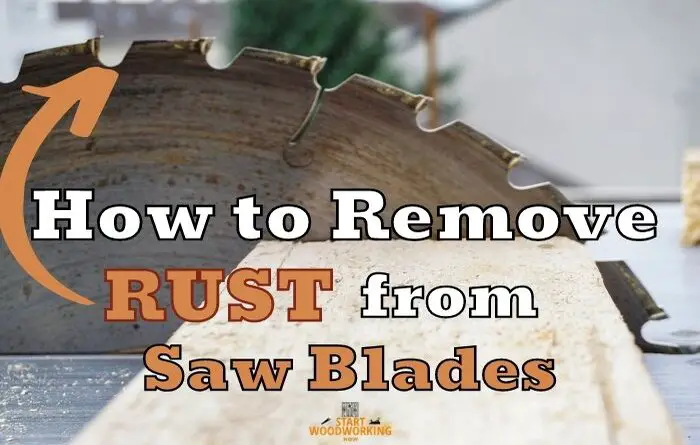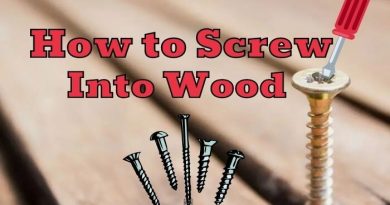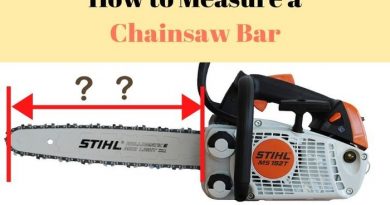How to Remove Rust from a Saw Blade [3 Easy Ways]
If you’ve found an old saw while out hunting for bargains (or rummaging around in your garage or basement) don’t let some rust put you off. You can easily see how to remove rust from a saw blade and restore it to near its original condition.
Once the rust is removed from the saw blade, however, it’s a good idea to keep it from coming back. Rust is actually the decomposition of the metal. And every time you remove a layer of saw blade rust, you remove a layer of metal.
How to Remove Rust from a Saw Blade: |
|---|
| 1. Using Lemon and Salt |
| 2. Using Vinegar |
| 3. With Coca Cola |
| 5. With Baking Soda |
| 6. With WD-40 |
| 7. Using Sandblasting |
| 8. With Oxalic Acid |
How to Remove Rust from Saw Blades using Homemade Methods
Rust on the saw blades not only looks ugly, it also affects the cutting power and shortens the life of the saws. Therefore, rust should be removed as soon as possible. There are a number of home remedies here that will quickly remove the saw blade rust and restore the cutting abilities.
How to Remove Rust from Saw Blades with Lemon
The best known method to remove rust from saw blades is to create a paste of salt and lemon:
- Just mix in a bowl salt and lemon in a proportion of 3 to 1, and spread the mixture on the saw blade surface to be treated.
- Leave the paste to act for half an hour, and remove it (which in the meantime will have ‘eaten’ the rust residues) with a damp sponge.
- Wipe the blade after that with a dry cloth, and at this point it is necessary to spread a layer of protective material, such as beeswax , melted in a bain-marie and distributed with a brush.
- If rust remains, we repeat the procedure and let the salt and lemon juice sit for another hour or two, until the rust is completely gone.
- After that rinse and dry the saw blade well.
- The lemon salt paste is also effective for removing rust stains from fabrics, to be applied before washing in the washing machine.
Ideal for : those not so tough or old rust blade stains. It is a great ally even for cleaning kitchen knives that have scratches or rust stains (especially those that are very old)
Advantages : it is a minimally abrasive method, and we use materials that we all have at home.
Disadvantages : you have to be careful when handling the blade being cleaned. We use protective gloves and, if necessary, a face protector, thus minimizing the risk of accidents.
How to Remove Rust from Saw Blades with Vinegar

Acid, particularly citric acid or acetic acid, is an excellent way to remove rust, especially if it forms on surfaces that can be easily soaked. If, say, you want to remove rust from saw blades or screws dip them in vinegar so that it covers the contents.
How to remove rust from saw blade using vinegar:
1.Soak the saw blades to be cleaned in weak white vinegar solution (1: 1) and let it rest overnight.
2.Use a cheap distilled white vinegar that you can buy in a supermarket.
3.If the saw blade is too large to be dipped in the white vinegar container, pour some on the surface and let it sit.
4.Try to dip aluminum foil in it as well and use it as a brush to remove rust. It is less abrasive than scouring pad, but it works the same way.
5.The next day, we remove it from the vinegar and scrape it off with a metal or steel wool brush.
6.Remove the saw blades from the solution and wipe them dry with a paper towel. Then clean the rust using steel wool.
7.If it is not possible to immerse the tool we want to clean in vinegar, we can apply the vinegar by soaking some rags with it and wrapping them around the rusted area.
8.If the saw blades are very rusty you should rinse them a second time, after the first layer of oxide falls off.
Ideal for : significant rust stains that we have on tools or elements that are made of steel and that we can submerge without compromising the integrity of other materials or surfaces.
Advantages : it is an almost effortless method. You dip it in, leave it there, and forget about it until the next day almost effortlessly.
Disadvantages : we have to immerse the object to be treated overnight, so it will take time to obtain results.
How to Remove Rust from Saw Blades With Baking Soda
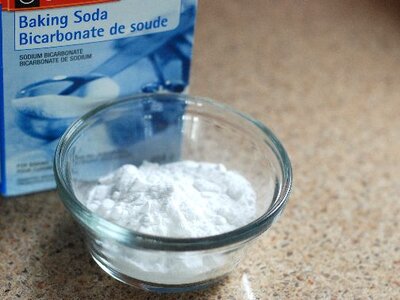
In the baking soda method, you will need to create some baking soda paste like it is described below:
Mixture of baking powder and baking soda
- Mix baking powder with baking soda (ratio 1: 1) and add a little water until you get a thick paste.
- Apply the paste to a sponge, leave it on for a while and use it to treat the infected objects.
- This paste is a relatively gentle cleaning method and is therefore particularly recommended for sensitive materials, for example stone tiles.
- You can also apply the paste to clothing and let it take effect.
Here is how to remove rust from saw blades with baking soda:
1.Apply the baking soda paste using a toothbrush in a generous amount to the saw blade.
2. Make sure that we cover all the blade areas that are rusted.
3. Scrub the rust from the saw blade with a toothbrush if the rust is not too severe.
4. If the saw blade is very rusty you will need a little more abrasion to remove the rust. Use a steel wood, but be careful not to damage the blade if you rub the rust too hard using the steel wool.
5. Let the baking soda paste rest for an hour or so, and then we will rub it with steel wool or a metal brush, removing the saw blade rust until we reach the metal.
6. When finished, rinse well and dry with a clean towel or cloth.
7. Another alternative is a slightly abrasive sponge. Be careful not to scrub too much as it can scratch the blade or ruin the finish.
8. Finally, wipe the blade with a cloth to remove the excess baking soda paste.
9. If you want to protect your blade from rust, you can apply a little oil afterwards to make sure it is lubricated and protected in the future.
Ideal for: less severe rust stains such as, light rust stains on tool surfaces and for thin metal objects like saw blades.
Advantages : it is a truly simple method in which I use a common and cheap ingredient that we all have in the kitchen at home.
Disadvantages : It will take us an hour before we can actually start removing rust from the blade surface. We must always combine it with the use of steel wool or scourer.
How to Remove Rust from Saw Blades With Coca Cola
Cola is often recommended as a home remedy for removing rust:
- Put your saw blades in a container with coca cola
- Let them soak overnight.
- Moisten a sponge or soft cloth with it and rub off the rust blade stains.
- Clean your blade using a cloth.
- This method is not entirely risk-free, as the caustic effect of the cola can also damage the rustproof material.
- Try it out on an inconspicuous area first.
How to Remove Rust from Saw Blades using Chemical Products
This is a radical method that will instantly remove rust from saw blades. The chemical solution interacts with iron oxide, dissolves it in a few minutes. Forms a protective film that further prevents re-rusting.
Using the example of the table, we will consider the advantages and disadvantages of chemicals, which are divided into two groups:
| Type of Chemical Products | Pros | Cons |
|---|---|---|
| Acidic | 1. No rinsing or additional processing required after application | 1. It is applied only to the centers of corrosion, as the acid corrodes intact metal 2. Phosphoric acid is toxic |
| Neutral | 1. Suitable for dense rust up to 150 microns 2. Does not destroy clean metal areas when in contact with them | 1. High price |
There are many products on the market to dissolve rust from saw blades. They are usually based on oxalic or phosphoric acid and are dangerous for the skin. Always take the right precautions when using them.
- Follow the directions on the label which are different for each product.
- Often these chemicals need to sit for a long time and need to be scrubbed, so be prepared to use elbow grease.
- They can also be expensive and only work on small spots.
How to Remove Rust from Saw Blades With WD-40
With the WD40 spray you can also remove rust from your blades. Spray WD-40 on the rusted saw blade surface, applying a sufficient amount and leave to act for 24 hours. Then clean the rusty surface with a wire brush.
If the rust on the saw blades does not come off after this steps you will have to sand the blades using a wire brush attached at a screwdriver or using a file. After this apply a final coat of WD-40 to get the best results and also prevent the risk of corrosion.
The WD-40 multifunction product can be used in two different ways:
- Either you carry out an individual spraying on your saw blades
- Allowing a pause time of 10 minutes for each one, before brushing delicately to remove the rust residues.
- Or you directly immerse your saw blades in a container filled with WD-40 multifunction product to remove the most stubborn rust stains.
Thanks to the product application rod, you will succeed in reaching the most inaccessible corners of your saw blade. You will also gain in precision by using the double position spray which allows you to spray each tool with a single gesture.
How to Remove Rust from Saw Blades using Oxalic Acid
Take precautions with this method: wear rubber gloves, goggles and protective clothing. Do not smoke or inhale acid fumes directly.
Here are the steps to remove rust from saw blades using oxalic acid:
- Wash the rusty object with liquid dish detergent, rinse and dry it carefully;
- Mix about 25ml (5ml = 1 teaspoon) of oxalic acid with 250ml of hot water;
- Leave the rusty saw blade in the oxalic acid for about twenty minutes.
- Clean the oxalic acid from the saw blade with a cloth or copper brush;
- Wash it completely and dry it once the rust is removed.
How to Remove Rust from Saw Blades using Metal Hand Brushes
One of the cheapest and easiest ways to remove rust from metal blade surfaces is using metal hand brushes. The bristle of the brush is made of steel and coated with brass (not all brushes have it). There are models in which a copper-zinc alloy is deposited on the surface of the pile, which is transferred to the saw blade during cleaning.
If none of these methods work, then you need to roll up your sleeves and work physically. Rust can be scraped off the blade metal surface. This is clearly easiest when the rust covers a large and easily accessible area.
First you need to decide what to use as a scraper. This will depend on how old the rust is.
If the rusty layer is thick, you can use a paint scraper or even a screwdriver. A metal sponge is just as good at cleaning as sandpaper.
Start with coarse grain paper, and when you’ve cleaned off the rust, switch to finer grain. The idea is to avoid scratching or damaging the metal.
This method is suitable for small surfaces and only for a thin layer of rust. Its convenience is that you can use a brush to crawl into hard-to-reach places, for example, to clean the inner surface of a cast-iron battery (for wide teeth). However, you will not be able to peel off a thick layer of rust.
Do you know how to unlock a miter saw ? In this guide you will know everything you need!
How to Remove Rust from a Hand Saw Blade
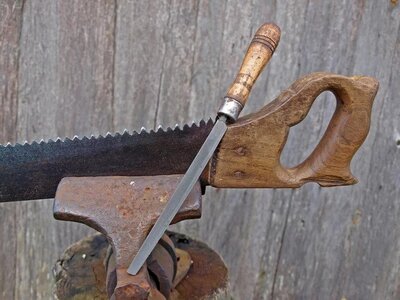
Step 1: Work Safely
Before cleaning your rusty saw blade, be sure to wear a good pair of gloves and a mask. They protect you not only from the sharp blade of your saw, but also from the White Spirit. Indeed, it can be irritating to the skin. Be sure to be extremely careful when cleaning your rusty saw.
Safety first! Obtain the necessary materials listed above and go to step 2 to prepare the work surface.
Step 2: Prepare the work surface
Old newspapers will prove to be great for protecting your table or any surface you plan to work on. It will also make the rusty saw cleaning process easier. This will allow you to easily remove rust residues.
Once the job is done, all you have to do is get rid of the newspaper. Position newspapers over the entire work area, ideally in your garage or workshop, on a workbench suitable for this kind of task.
Step 3: Remove most of the saw blade rust with a scrapper
You can now move on to cleaning your rusty saw. We recommend that you use a blade scraper to remove rust from your saw blade. To do this, take your scraper and scrape from one end of the blade to the other.
Scrape off in spurts until all the rust is removed. You can also use a wire brush or even a drill with a wire brush attachment. Choose the method that works best for you to remove most of the rust.
Step 4: Finalize the rust removal with a sandpaper
Once the maximum amount of rust has been removed, sand the blade with a fine sandpaper using a little White Spirit to speed up the rust removal process of your saw. Make sure to use a small amount of White Spirit and don’t forget to put on your gloves and mask!
You can use different types of sandpaper. In any case, always start from the coarse grain, to the finest, to finish with a smooth metal. You can use a sander for this step to make the job easier. Be careful not to damage the metal too much!
Step 5: Protect the hand saw blade against rust
Now that you have cleaned your rusty saw, we recommend that you protect the blade against the appearance of corrosion with the WD-40 . Agitate the product and spray it on the saw blade.
Wipe off excess product with a rag. You will notice that by rubbing with the cloth, the rust still present should come off easily. Repeat the process until you are completely satisfied.
How to Remove Rust from a Table Saw Blade
In the event that the rust is more intense, you will need to prepare for a more extreme operation. Be aware that the procedure will be exactly the same for any type of table saw , such as a jobsite table saw , contractor table saw, hybrid saw, or table circular saw.
Now that you have enough equipment to remove the rust, it’s time to take your table saw apart .
The method is simple:
- Start by unplugging it from a power source.
- Once it’s safe to get started, start the table saw and take out the corroded parts. Typically, rust only occurs on the saw itself. However, there are cases when you will have to take the entire power tool apart into small pieces and remove the rust all over.
- Apply the solution to the corroded surface and use sandpaper to remove the rust.
- Once you are done make sure to clean the surface, then use a protective layer and then scrub using a microfiber fabric.
- To get rid of the surface rust you will need a synthetic scouring pad or any 400 grit wet/dry sandpaper and some kind of lubricating mineral oil or WD-40 would also be acceptable for this.
- To remove rust, simply use the lubricant with a rag and wash together using the sandpaper or scouring pad.
- Keep working until all of the rust is gone, being careful not to neglect any edges or cracks.
- Make sure that no rust is left behind if you run out of it, it will immediately start to disperse.
- After you are finished, clean the surface and apply a protective coating which will ensure that the chosen blade does not corrode in the future.
Conclusion
Whether natural or industrial solutions, all methods of removing rust from a saw blade have been shown to be effective. The difference lies in the price, time and energy that we are willing to spend. The industrial product is indeed the most expensive solution, but it is fast and requires little scratching.

